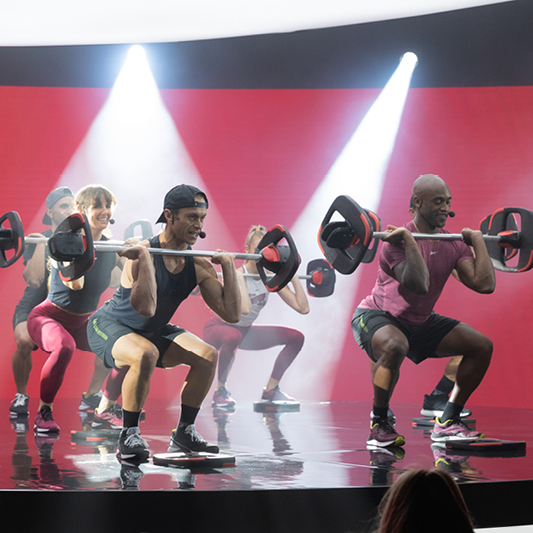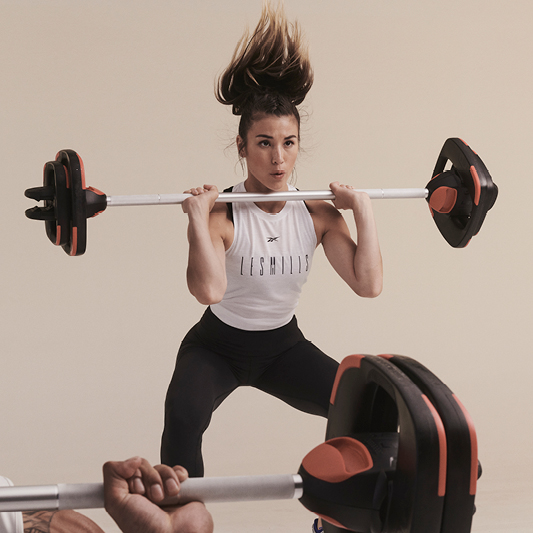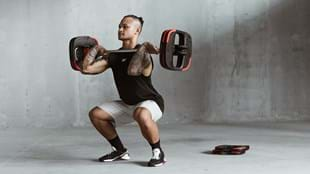“I’d ask that people try to understand something before judging it,” says Glen Ostergaard, Program Director for BODYPUMP™. “All of our programs need to continuously evolve so we can stay relevant. And BODYPUMP is no different. I don’t want BODYPUMP to become insignificant and die off because we didn’t keep pace with what the next generation want.”
The latest innovation to arrive in BODYPUMP is the barbell front squat with a clean grip, which appears as an option in both the Warm-Up and Squat Track in Release 118, and is also featured in the following release, 119. So why have the front squat AND calf raises been included in the squat track this round?
FRONT SQUAT: DEVELOP A STRONGER CORE
Experts estimate that 80 percent of us will experience a back problem at some point in our lives. A whopping 540 million people are thought to be dealing with back pain right now. In the United States alone, back pain accounts for 2.6 million emergency visits each year, with almost $50bn spent annually on the issue. It’s also one of the most common reasons for missed work.
Kinesiology researcher, Dr. Gillian Hatfield says most low back pain can be pinned on low back muscle weakness. The front squat is an excellent way to improve our core strength because of demands placed on the erector spinae muscles to maintain the high chest position. The front squat can increase strength in this region, helping us to reduce some of the risks associated with lower back pain.
TIP: Given these additional demands placed on the core, you should notice that the front squat does feel more intense than the back squat as we utilize muscle groups in a slightly different way to achieve the same movement. Try starting with a lighter weight to adjust to the new positioning of the barbell. As you start to feel more comfortable with the movement, increase the weight over time to increase the benefits from the added stimulus.
INCREASE LOWER BODY STRENGTH
Want to avoid plateauing in your training? Changing the position of the barbell provides a different training stimulus to generate new muscular challenges. When the barbell is held in a front squat position, the body is naturally pulled forward of our center of gravity. This forces our stabilizers to react to this new position to control our trunk position. Meanwhile, our primary target muscles – the quads and glutes – adapt to driving vertically against the change in the direction of resistance. Researchers have found increases in quadricep activation and less trunk incline with a front squat, as opposed to a back-loaded squat.

IMPROVE MOBILITY AND POSTURE
Sitting for long periods hunched over a computer screen increases our risk of developing kyphosis – the condition of having an increase in the outward curvature of the spine in the upper back. Postural kyphosis is aggravated by poor posture, and that’s where exercises like the front squat can help.
Lifting the barbell in a front rack position recruits the muscles of the upper back and increases the demands on the thoracic extensors to maintain the high chest position. This thoracic extension can help to correct kyphosis – the rounded shoulders that often present in office workers.
CALF RAISES: GET STRONGER FOR EVERYDAY LIFE
“When you lift your heels up off the ground, you are performing ankle extension, and the muscles in the back of your lower leg are active,” says Dr. Jinger Gottschall, fitness academic. “There are actually three muscles responsible for this movement: medial gastrocnemius (superficial, towards the body center), lateral gastrocnemius (superficial, away from the body center) and soleus (under gastrocnemius). These three muscles join at the lower end of the calf and share a tendon, the Achilles tendon, which attaches to the heel.
“The calf muscles, particularly the gastrocnemius, play an important role in walking, running, stair climbing, cycling and jumping. They are the primary group for propulsion forward and upward during these common activities. Therefore, the gastrocnemius muscles are critical for successful execution of exercises in BODYATTACK™, BODYSTEP™, BODYCOMBAT™, LES MILLS GRIT™, and each of the dance and cycling programs.”
ENHANCE ATHLETIC PERFORMANCE
“When the heel lift is added to the upright row and squat, there is extension at the knee and hip as well as the ankle,” says Gottschall. “This is referred to as triple extension! At the bottom of a squat, all three joints are flexed. As you initiate the rise, the hips extend, followed by the knees, and finally the ankles. This final extension at the ankles provides additional power, increasing overall activation and enhancing lower leg training. It is important to keep these muscles engaged and healthy to assist in maximizing performance of sports that involve running and jumping as well as maintaining independence for the functional tasks of walking and stair climbing.”

HOW TO COACH THESE INTEGRATED EXERCISES?
A key reason behind the inclusion of moves like the front squat is to give members more autonomy over their training. “People have more workout choices than ever before,” says Les Mills Creative Director Kylie Gates. “Demonstrating and offering the front squat as an option gives people more control over their experience and provides a different feel to the workout. You don’t have to stay with it – but do show it as an option for at least a few reps and let your participants decide for themselves if they want to try it or not.”
“It’s fun, challenging and gives PUMP a modern training feeling,” says Ostergaard. “When teaching the front squat, it needs to be set up correctly and a lighter weight is required.”
“Inform and educate your participants about triple extension in calf raises,” adds Gottschall. “Explain that we are performing an integrated exercise with activity from the hip (glutes), knee (quads, hamstrings), and ankle (gastroc) muscles. Make sure to maintain the critical cues of consciously contracting the glutes and bracing the core as you rise from a squat. Then add the heel lift component to fire the calf muscles.
“Once your participants have the basic movement pattern, increase their enthusiasm by asking: Do you want to run faster? Jump higher? Walk longer? If so, bring on the triple extension!”
REFERENCES
Gullett, JC, Tillman, MD, Gutierrez, GM and Chow, JM. A biomechanical comparison of back and front squats in healthy trained individuals. Journal of Strength and Conditioning Research 23(1)/284–292, 2009.
Comfort, P, Pearson, SJ and Mather, M. An electromyographical comparison of trunk muscle activity during isometric trunk and dynamic strengthening exercises. Journal of Strength and Conditioning Research 25(1)/149–154, 2011.
Yavuz, HU, Erdag, D, Amca, AM and Aritan, S. Kinematic and EMG activities during front and back squat variations in maximum loads. Journal of Sports Sciences Vol. 33, No. 10, 1058–1066, 2015.



